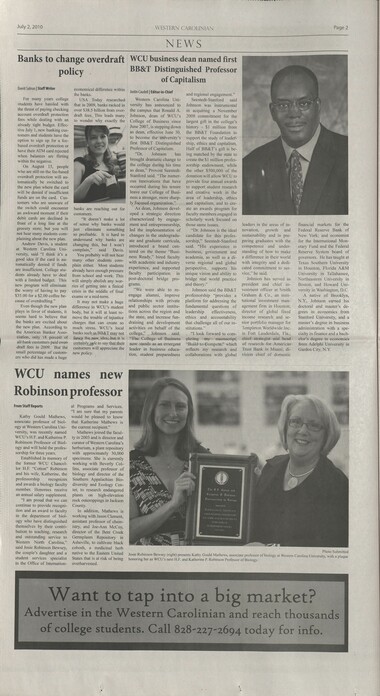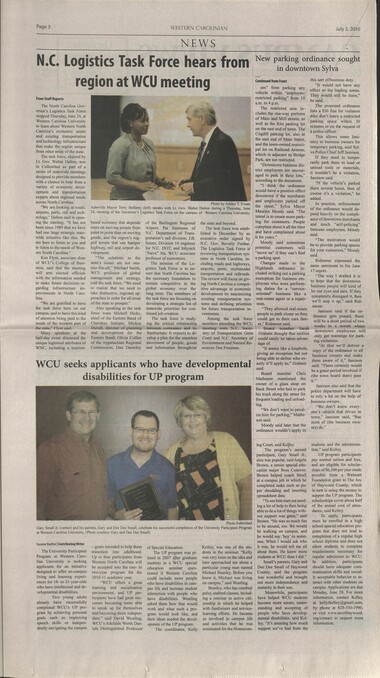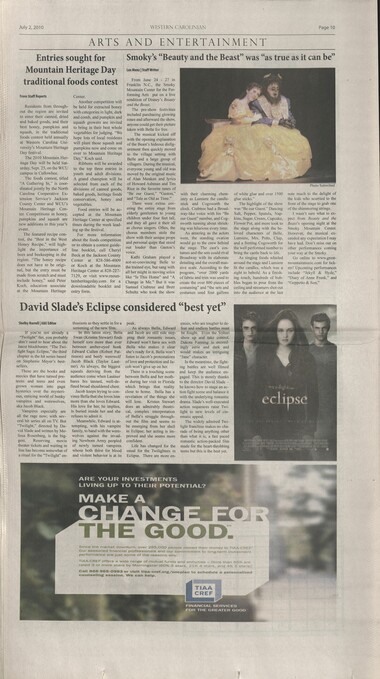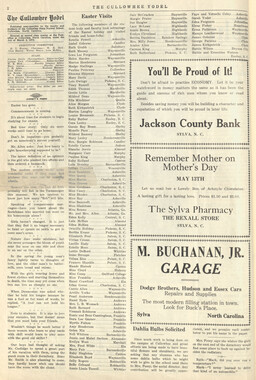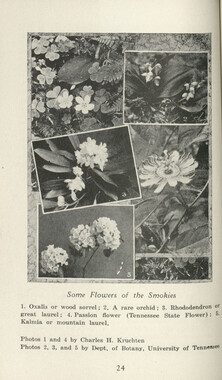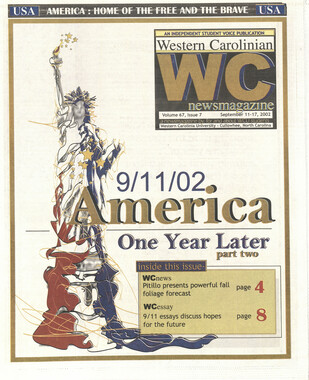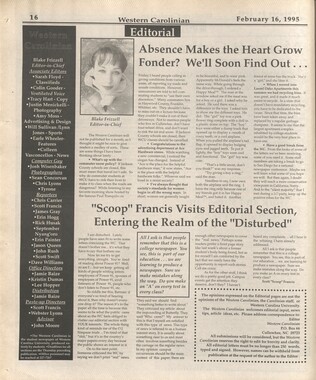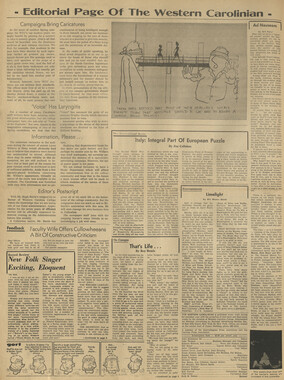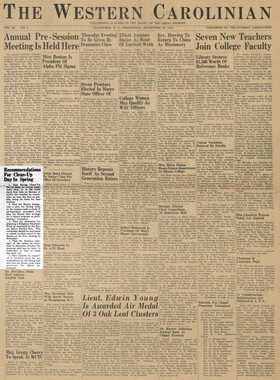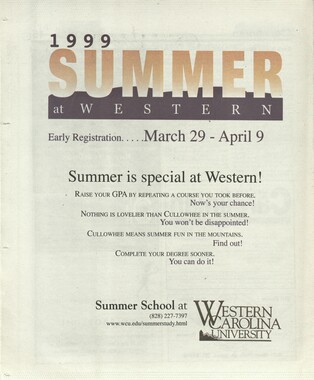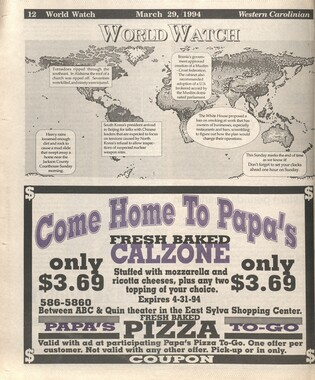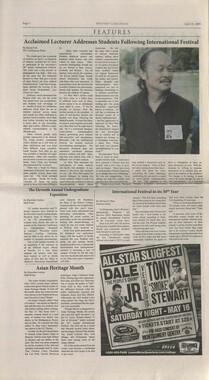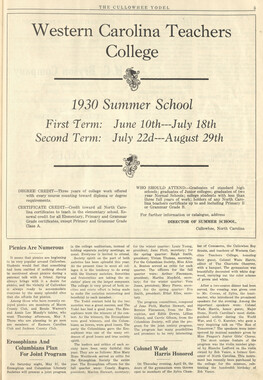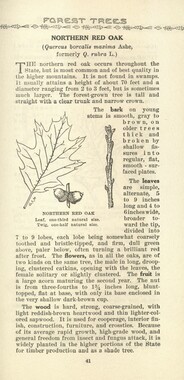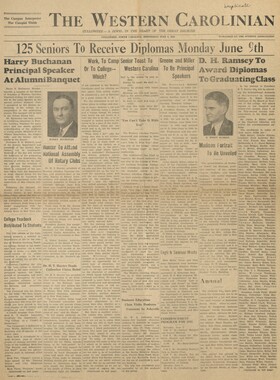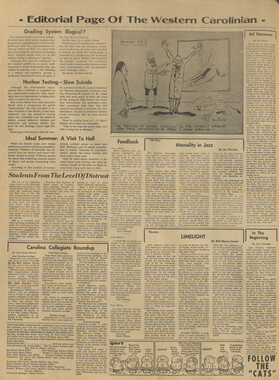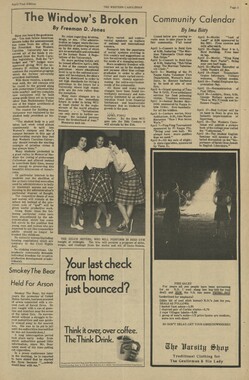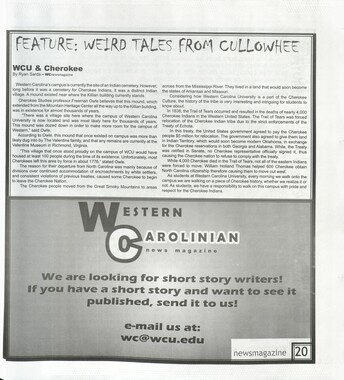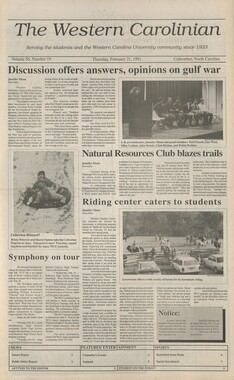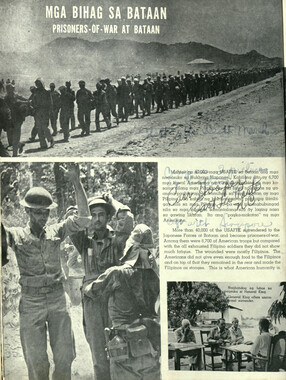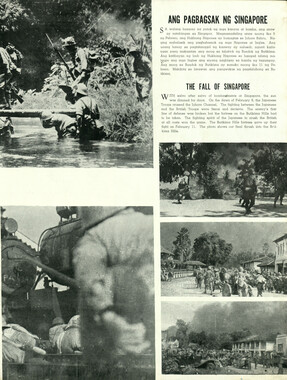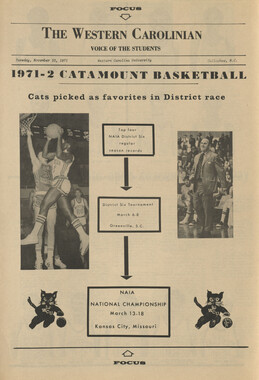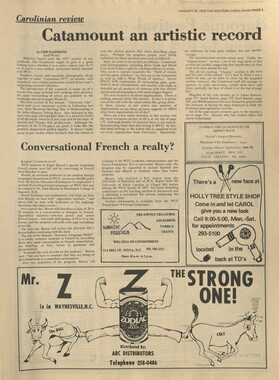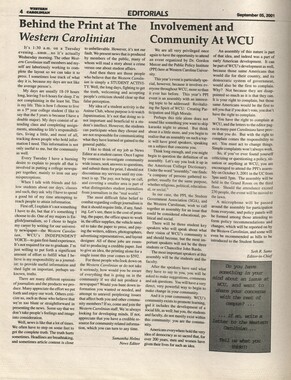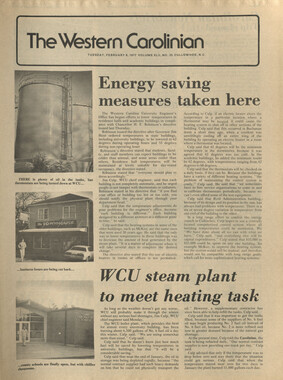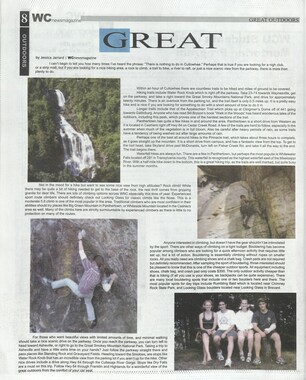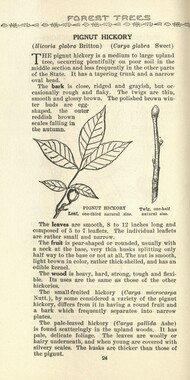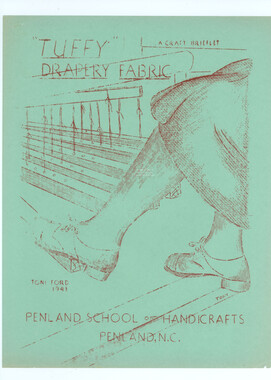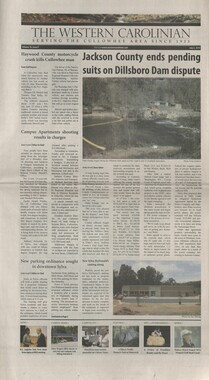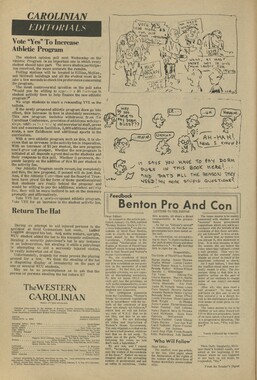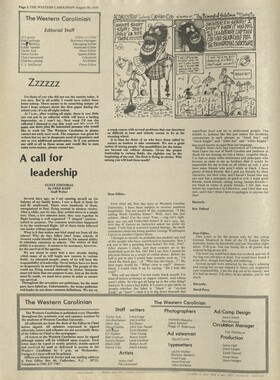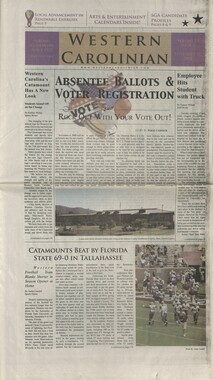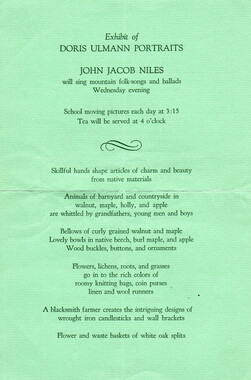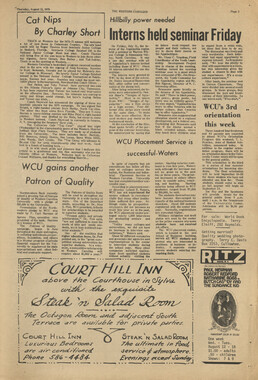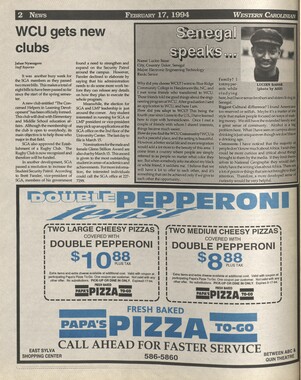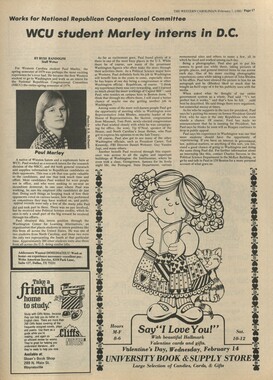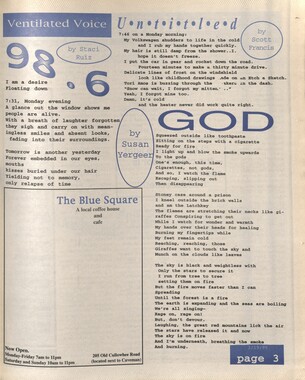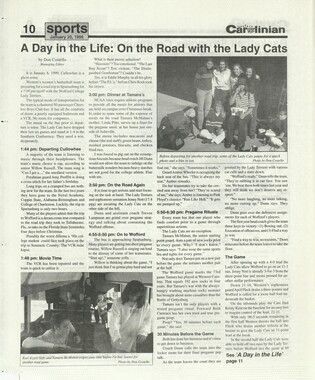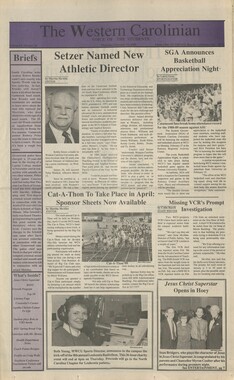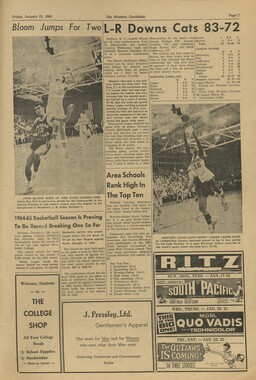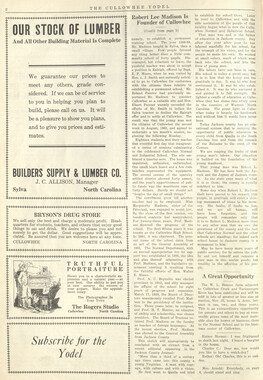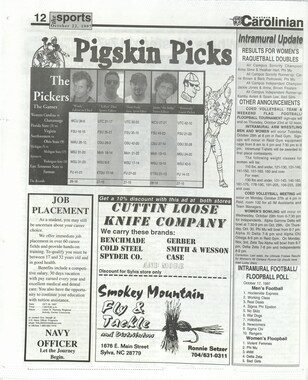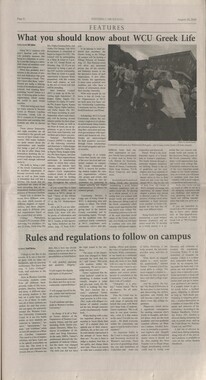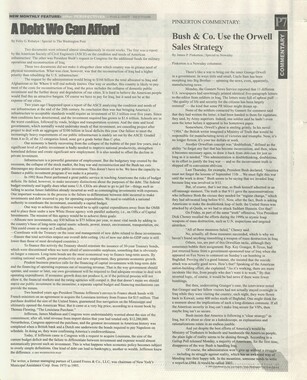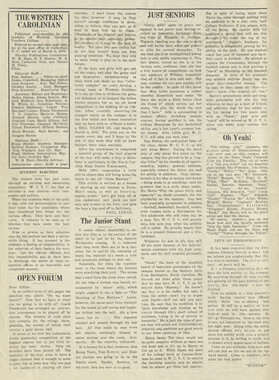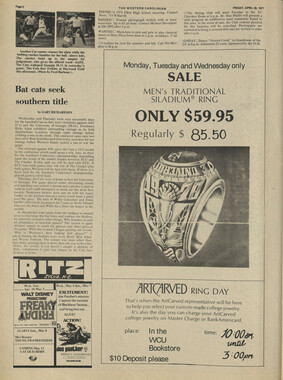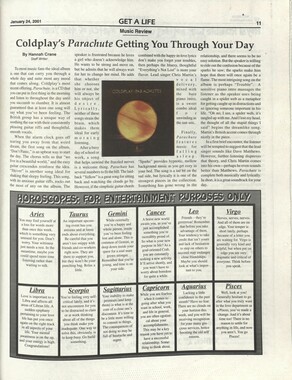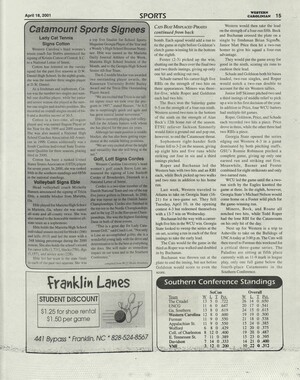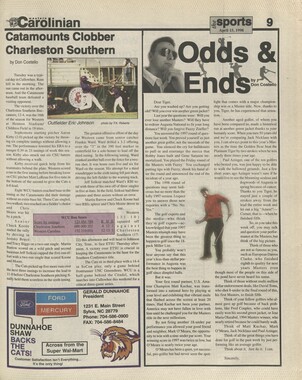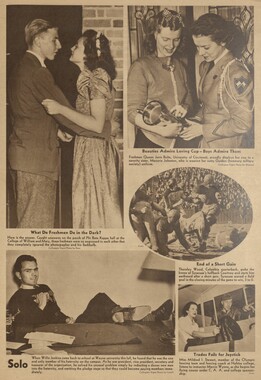Western Carolina University (20)
View all
- Canton Champion Fibre Company (2308)
- Cherokee Traditions (291)
- Civil War in Southern Appalachia (165)
- Craft Revival (1942)
- Great Smoky Mountains - A Park for America (2946)
- Highlights from Western Carolina University (430)
- Horace Kephart (941)
- Journeys Through Jackson (159)
- LGBTQIA+ Archive of Jackson County (85)
- Oral Histories of Western North Carolina (314)
- Picturing Appalachia (6873)
- Stories of Mountain Folk (413)
- Travel Western North Carolina (160)
- Western Carolina University Fine Art Museum Vitreograph Collection (129)
- Western Carolina University Herbarium (92)
- Western Carolina University: Making Memories (738)
- Western Carolina University Publications (2491)
- Western Carolina University Restricted Electronic Theses and Dissertations (146)
- Western North Carolina Regional Maps (71)
- World War II in Southern Appalachia (131)
University of North Carolina Asheville (6)
View all
- Allanstand Cottage Industries (62)
- Appalachian National Park Association (53)
- Bennett, Kelly, 1890-1974 (1463)
- Berry, Walter (76)
- Brasstown Carvers (40)
- Carver, George Washington, 1864?-1943 (26)
- Cathey, Joseph, 1803-1874 (1)
- Champion Fibre Company (233)
- Champion Paper and Fibre Company (297)
- Cherokee Indian Fair Association (16)
- Cherokee Language Program (22)
- Crowe, Amanda (40)
- Edmonston, Thomas Benton, 1842-1907 (7)
- Ensley, A. L. (Abraham Lincoln), 1865-1948 (275)
- Fromer, Irving Rhodes, 1913-1994 (70)
- George Butz (BFS 1907) (46)
- Goodrich, Frances Louisa (120)
- Grant, George Alexander, 1891-1964 (96)
- Heard, Marian Gladys (60)
- Kephart, Calvin, 1883-1969 (15)
- Kephart, Horace, 1862-1931 (313)
- Kephart, Laura, 1862-1954 (39)
- Laney, Gideon Thomas, 1889-1976 (439)
- Masa, George, 1881-1933 (61)
- McElhinney, William Julian, 1896-1953 (44)
- Niggli, Josephina, 1910-1983 (10)
- North Carolina Park Commission (105)
- Osborne, Kezia Stradley (9)
- Owens, Samuel Robert, 1918-1995 (11)
- Penland Weavers and Potters (36)
- Roberts, Vivienne (15)
- Roth, Albert, 1890-1974 (142)
- Schenck, Carl Alwin, 1868-1955 (1)
- Sherrill's Photography Studio (2565)
- Southern Highland Handicraft Guild (127)
- Southern Highlanders, Inc. (71)
- Stalcup, Jesse Bryson (46)
- Stearns, I. K. (213)
- Thompson, James Edward, 1880-1976 (226)
- United States. Indian Arts and Crafts Board (130)
- USFS (683)
- Vance, Zebulon Baird, 1830-1894 (1)
- Weaver, Zebulon, 1872-1948 (58)
- Western Carolina College (230)
- Western Carolina Teachers College (282)
- Western Carolina University (2008)
- Western Carolina University. Mountain Heritage Center (18)
- Whitman, Walt, 1819-1892 (10)
- Wilburn, Hiram Coleman, 1880-1967 (73)
- Williams, Isadora (3)
- Cain, Doreyl Ammons (0)
- Crittenden, Lorraine (0)
- Rhodes, Judy (0)
- Smith, Edward Clark (0)
- Appalachian Region, Southern (2569)
- Asheville (N.C.) (1923)
- Avery County (N.C.) (26)
- Blount County (Tenn.) (195)
- Buncombe County (N.C.) (1672)
- Cherokee County (N.C.) (283)
- Clay County (N.C.) (555)
- Graham County (N.C.) (236)
- Great Smoky Mountains National Park (N.C. and Tenn.) (519)
- Haywood County (N.C.) (3569)
- Henderson County (N.C.) (70)
- Jackson County (N.C.) (4912)
- Knox County (Tenn.) (35)
- Knoxville (Tenn.) (13)
- Lake Santeetlah (N.C.) (10)
- Macon County (N.C.) (420)
- Madison County (N.C.) (215)
- McDowell County (N.C.) (39)
- Mitchell County (N.C.) (132)
- Polk County (N.C.) (35)
- Qualla Boundary (982)
- Rutherford County (N.C.) (76)
- Swain County (N.C.) (2182)
- Transylvania County (N.C.) (270)
- Watauga County (N.C.) (12)
- Waynesville (N.C.) (86)
- Yancey County (N.C.) (72)
- Aerial Photographs (3)
- Aerial Views (60)
- Albums (books) (4)
- Articles (1)
- Artifacts (object Genre) (228)
- Bibliographies (1)
- Biography (general Genre) (2)
- Cards (information Artifacts) (38)
- Clippings (information Artifacts) (191)
- Copybooks (instructional Materials) (3)
- Crafts (art Genres) (622)
- Depictions (visual Works) (21)
- Design Drawings (1)
- Drawings (visual Works) (185)
- Envelopes (73)
- Exhibitions (events) (1)
- Facsimiles (reproductions) (1)
- Fiction (general Genre) (4)
- Financial Records (12)
- Fliers (printed Matter) (67)
- Glass Plate Negatives (381)
- Guidebooks (2)
- Internegatives (10)
- Interviews (815)
- Land Surveys (102)
- Letters (correspondence) (1013)
- Manuscripts (documents) (618)
- Maps (documents) (177)
- Memorandums (25)
- Minutes (administrative Records) (59)
- Negatives (photographs) (6090)
- Newsletters (1290)
- Newspapers (2)
- Notebooks (8)
- Occupation Currency (1)
- Paintings (visual Works) (1)
- Pen And Ink Drawings (1)
- Periodicals (193)
- Personal Narratives (10)
- Photographs (12976)
- Plans (maps) (1)
- Poetry (5)
- Portraits (4568)
- Postcards (329)
- Programs (documents) (181)
- Publications (documents) (2443)
- Questionnaires (65)
- Relief Prints (26)
- Sayings (literary Genre) (1)
- Scrapbooks (282)
- Sheet Music (2)
- Slides (photographs) (402)
- Songs (musical Compositions) (2)
- Sound Recordings (796)
- Specimens (92)
- Speeches (documents) (18)
- Tintypes (photographs) (8)
- Transcripts (322)
- Video Recordings (physical Artifacts) (23)
- Text Messages (0)
- A.L. Ensley Collection (275)
- Appalachian Industrial School Records (7)
- Appalachian National Park Association Records (336)
- Axley-Meroney Collection (2)
- Bayard Wootten Photograph Collection (20)
- Bethel Rural Community Organization Collection (7)
- Blumer Collection (5)
- C.W. Slagle Collection (20)
- Canton Area Historical Museum (2110)
- Carlos C. Campbell Collection (462)
- Cataloochee History Project (64)
- Cherokee Studies Collection (4)
- Daisy Dame Photograph Album (5)
- Daniel Boone VI Collection (1)
- Doris Ulmann Photograph Collection (112)
- Elizabeth H. Lasley Collection (1)
- Elizabeth Woolworth Szold Fleharty Collection (4)
- Frank Fry Collection (95)
- George Masa Collection (173)
- Gideon Laney Collection (452)
- Hazel Scarborough Collection (2)
- Hiram C. Wilburn Papers (28)
- Historic Photographs Collection (236)
- Horace Kephart Collection (861)
- Humbard Collection (33)
- Hunter and Weaver Families Collection (1)
- I. D. Blumenthal Collection (4)
- Isadora Williams Collection (4)
- Jesse Bryson Stalcup Collection (47)
- Jim Thompson Collection (224)
- John B. Battle Collection (7)
- John C. Campbell Folk School Records (80)
- John Parris Collection (6)
- Judaculla Rock project (2)
- Kelly Bennett Collection (1482)
- Love Family Papers (11)
- Major Wiley Parris Civil War Letters (3)
- Map Collection (12)
- McFee-Misemer Civil War Letters (34)
- Mountain Heritage Center Collection (4)
- Norburn - Robertson - Thomson Families Collection (44)
- Pauline Hood Collection (7)
- Pre-Guild Collection (2)
- Qualla Arts and Crafts Mutual Collection (12)
- R.A. Romanes Collection (681)
- Rosser H. Taylor Collection (1)
- Samuel Robert Owens Collection (94)
- Sara Madison Collection (144)
- Sherrill Studio Photo Collection (2558)
- Smoky Mountains Hiking Club Collection (616)
- Stories of Mountain Folk - Radio Programs (374)
- The Reporter, Western Carolina University (510)
- Venoy and Elizabeth Reed Collection (16)
- WCU Gender and Sexuality Oral History Project (32)
- WCU Mountain Heritage Center Oral Histories (25)
- WCU Oral History Collection - Mountain People, Mountain Lives (71)
- WCU Students Newspapers Collection (1923)
- Western North Carolina Tomorrow Black Oral History Project (69)
- William Williams Stringfield Collection (2)
- Zebulon Weaver Collection (109)
- African Americans (390)
- Appalachian Trail (35)
- Artisans (521)
- Cherokee art (84)
- Cherokee artists -- North Carolina (10)
- Cherokee language (21)
- Cherokee pottery (101)
- Cherokee women (208)
- Church buildings (189)
- Civilian Conservation Corps (U.S.) (111)
- College student newspapers and periodicals (2012)
- Dams (107)
- Dance (1023)
- Education (222)
- Floods (61)
- Folk music (1015)
- Forced removal, 1813-1903 (2)
- Forest conservation (220)
- Forests and forestry (1184)
- Gender nonconformity (4)
- Great Smoky Mountains National Park (N.C. and Tenn.) (181)
- Hunting (45)
- Landscape photography (25)
- Logging (119)
- Maps (83)
- Mines and mineral resources (8)
- North Carolina -- Maps (18)
- Paper industry (38)
- Postcards (255)
- Pottery (135)
- Railroad trains (72)
- Rural electrification -- North Carolina, Western (3)
- School integration -- Southern States (2)
- Segregation -- North Carolina, Western (5)
- Slavery (5)
- Sports (452)
- Storytelling (243)
- Waterfalls -- Great Smoky Mountains (N.C. and Tenn.) (66)
- Weaving -- Appalachian Region, Southern (280)
- Wood-carving -- Appalachian Region, Southern (328)
- World War, 1939-1945 (173)
Western Carolinian Volume 76 Number 08
Item
Item’s are ‘child’ level descriptions to ‘parent’ objects, (e.g. one page of a whole book).
-
-
July 2, 2010 WESTERN CAROLINIAN Page 8 FEATURES \ A - Joshua Farmer | Features Editor For the average WCU stu- _ dent, beef is a food commonly | shared with friends and adult beverages in the summer whether its over a grill or pan, or even over a common outdoor campfire. Whatever. form of cooking is used, be- lieve it or not, the beef we eat daily has become an impor- . tant part of American society and culture. Cattle were introduced by the Spanish in Mexico in the mid 1540s, but wasnt com- mon in the United States until after the Civil War. This was simply because of transporta- tion and storage issues. Plus, beef is also perishable when freshly slaughtered. To keep beef in storage, or aging as it is called, facilities must be built to age or refrigerate it. Practical refrigeration tech- niques did not exist until the turn of the century, leaving those with a hunger for steak waiting for herds from the mid-eastern United States. With the arrival of tech- nological advances and bet- ter farming techniques, beef became more popular. Many of the first slaughterhouses sprang up in large cities such as New York and Chicago. These butchers were often im- migrants from European na- tions hoping to make a better life in the growing US econ- omy. This historical aspect is displayed in the modern mov- ie, Gangs of New York. With the invention of re- frigeration and other technol- ogies that better preserved the beef, it became an important part of the American diet. Af- Beef History Choice grading is given to meat often found at retail stores such as Ingles, pictured. ter World War II, Americans consumed an average of 60 Ibs of beef yearly. By the early 70s, it was closer to 100 Ibs. According to the USDA web- site, consumption has leveled at about 70 Ibs per year. Then, as it is today, eating a steak or broiling a roast symbolized prosperity for the consumer. For the average consum- er, beef usually begins its journey to the plate or grill through a feed lot. To the cha- grin of many animal rights activists, these farms are in- humane to the cattle because of the crowded conditions in which the animals live. How- ever, these cattle are fed daily with a corn-based feed full of , nutrients. There are also cattle raised: strictly open-range, which is when. the farmers raising them allow them to graze freely. " Many of us have gone to Wal-Mart to buy steaks. Have you ever noticed the mar- bling, or fat within the meat, or looked for a grade? Beef actually has eight grades. For meat connoisseurs this is three more than chicken, lamb or veal. The Prime desig- nation is given to beef that is generally served in hotels and restaurants. It features a high level of marb._... Choice grading is given to meat of- ten found at retail stores such as Wal-Mart, Ingles or Food Lion. For the average con- sumer, the Select rating can often be found at discount retailers as well. Beef is also graded as Standard, Com- mercial, Utility, Cutter and Canner. The former two are also sold to many retailers. The latter three are used for Photo by Jay Strong ground beef (hamburger) or other processed meat prod- ucts. ; Meat also has yield grades. According to the USDA web- site these grades, range from 1 to S? and indicate the amount of usable meat from a carcass. The yield ratings are also based on the amount of fat within the meat. Though some consumers prefer lean meat, it is generally accepted that fatter meat produces a better flayor without season- ing, Beef is most popularly used as ground beef. It is used in spaghetti, for hamburgers and for various other meals. Americans eat an average of 28 ibs of ground beef yearly, per person. You would think this number would be much higher considering the afford- ability and relative ease in its | preparation. Beef is also used in other products such as dog food, margarine and in sau- sage. Amazingly, beef bones | | and skin are also used in the | production of items such as chewing gum, candy and marshmallows. With a popular food source such as beef, there are always critics. According to Alive. com, beef contributes to an increased risk of contract- ing heart disease, cancer and various other ailments. Over- consumption of beef products can also raise blood pressure and contribute to a lower sex drive. choose to consume your beef, it has a long and storied his- tory as one of mankinds most important national food sources. Solar Flares: Why they matter Joshua Farmer | Features Editor Solar flares are a common but often misunderstood phe- nomenon that occurs on the surface of the Sun. These flares, when active, can . sometimes release more energy than all of what mankind has ever pro- duced. For an average student at WCU, their cell phone is a part of everyday life. For some stu- dents it is an absolute lifeline for common communication, gos- sip and a way to take pictures of things that they see and enjoy. But like most items that are me- chanical or electronic, they too can eventually fail or have a dis- ruption in service. In most cas- es, simply charging the battery, or moving to another location for better service can fix these problems.. Sometimes, though, Mother Nature has other plans. Often, they are the diameter of 3 or 4 earths. These flares, which are actually large bursts of gas (plasma) exploding rather than actual fires, ironically oc- cur in cycles of about 11 years generally around large spots (sunspots) on the surface of the Sun. But why would that have anything to do with Earth? The gas that explodes in a so- lar flare is called plasma. Plasma is a gas where a percentage of the particles within the gas ion- ize. This gas then responds elec- trically to any magnetic field around it; in this case because it is the sun and it is burning, it ex- plodes. Plasma is quite compli- cated in that it reacts as if it were a gas but also differing from a gas in that it can be influenced by those magnetic fields. Again though, how would that affect a WCU student? In. December 2006, astro- nauts in the International Space Station were forced to take cov- er from a solar flare. Because of the UV and X-Rays emit- ted from the ejection of plasma (off the surface of the Sun) the effects can be damaging to the - human body. According to Ex- tremetech.com, this particular flare also interrupted radio waves in China while also dis- rupting the operation of a satel- lite. As most of us know, digital signals (cell phones) are relayed from Earth to the satellite and back, creating that wireless net- works we know and love. The largest solar flare Known to date occurred in 1859 and was documented through the use of chemicals tests to detect particles trapped in ice. Because a solar flare can affect any elec- tronic system, it can also be damaging to power grids. In 1989, 6 million people lost power because of a solar flare. A large-scale solar storm could potentially damage the electron- ic communications of the entire United States. Many WCU students use wireless Internet connections. These'connections are still based from an electronic sourceof>. ten a broadcast antenna or rout- er. The computers that connect so much of our technologically based society are also plugged into electronic power. Military, commercial and private means of transport of goods and ser- vices rely on electricityall of which can be disrupted by an - angry Sun. As solar activity never ceas- es, the next time you wonder why you have bad reception, or the Internet isnt buffering that Hulu movie quick enough, con- sider the possibility that our sun is the cause. Whatever way you | A closer look at the BP Gulf Oil Spill Doug Bridges | Contributing Writer As anyone who has been recently watching the news knows the BP oil spill off the coast of Louisiana has become a major issue. Cries for more environmental regu- lation have been heard, and are ver increasingly getting louder. On April 20 the BP rig off the coast of Louisiana exploded, killing 11 crew members, and over the next couple days oil flowed con- tinually unchallenged into the Gulf of Mexico. Efforts have been in- creased to stop the flow of oil into the Gulf, but all thus far have failed. Former WCU Environmental Senator Ben- jamin Collette said a horrible autocracy what those BP guys have done to the Gulf. The Gulf has been treated horribly for years now, cause of the flow from the Mississippi River and all the chemicals dumped in it, but this is just outrageous. The hazards of an oil spill come in three main forms, environmental, economic, and to wildlife. When an oil spill occurs depending on the density, and elemental composition of the oil, multiple reactions are possible. These include oil floating on top of the water, and if the oil is denser then it can dissolve slightly into the water and leaving sludge on the top, which could go on to STts j damage the coastline envi- ronment further. Shoreline damages can led to the polluted beaches, and contaminated vegetation. The wildlife are affected by the damages that the veg- etation and coastline endure. Fish"are poisoned by the tox- ic materials that are produced by the dissolution of oil into the water, which results in the deaths of many sea creatures. As the oil hits shorelines, this can affect other animals as well, which can lead to any- thing from damages to the re- production cycle to a distor- tion of natural behaviors the animals undergo. Another problem for the wildlife comes when the food chain is affected due to the deaths of some key figures in the process. The residue left by sludge that comes onto shore eventually in part evap- orates and can have some affect on the water cycle/ The result of the wildlife and environment suffers in the event of oil spills is the rea- son for economic troubles the area affected by the spill be endure. Using the example of the Louisiana spill, the fish- ing industry has been all but destroyed, and many that rely on fishing as their sole means of income have found them- selves without a job, due to the fish population being contaminated by the toxic chemicals the fish are pro- longed to. - The BP company as a fe- sult of this particular spill has suffered huge losses includ- ing: $1.25 billion spent on at~ tempting to fix the problem, 20,000 to 40,000 barrels of oil wasted due to the oil spill, shares of the company sink- ing 17% (roughly $23. bil- lion), and also having to pay individuals/ who have suf- fered income loss to anyone who has a legit claim against the company due solely to the oil spill. President Obama an- nounced on April 30 as a result of the oil spill that no new drilling would be al- lowed on the coast. He saw that the prolonged effects on the environment as being very serious, and the need for government interaction in dealing with this matter. The hazards of the oil spill will surely led to a stricter envi- ronmental policy under the Obama administration. Y think that the govern- ment should at this point see what the damage of the off shore drilling is doing to the environment, and if compa- nies want to continue then regulations should be stricter on the companies to help pre- vent something like this from happening again, said Col- lette. I mean, I go shrimping like the fishermen in the Gulf do, and I love shrimp, but shrimp is meant to be dipped in cocktail sauce, not oil. A Hikers Profile Pinnacle Park has a network of side trails that offer interesting sights, Jay Strong | WCintem My personal favorite hike in the Cullowhee area is only a short drive from campus, and is the perfect place to go for a strenuous daylong hike with a group of friends. Its also a great place to go if you want to be by yourself. Pin- nacle Park, which, in addition to the main trail to a great overlook at the Pinnacle, has a network of side trails that can atake you all the way to Waterrock Knob on the Blue Ridge Parkway. According to the signs at the trail, head, the hike to the Parkway is 6.2 miles one way. If youre going with a group of friends, you could take two cars and park one at Waterrock Knob, and the oth- er at the parking lot of Pinna- cle Park, and walk between. If you go by yourself, it will mean a 12.4 mile round-trip hike. The 12.4 mile hike usu- ally takes between 9 9.5 hours, so be sure to bring plenty of water and a lunch. To get to the entrance of Pinnacle Park, take Highway 107 into Sylva, take a right at the main intersection (where Bogarts is), and turn left at McDonalds onto Skyland Dr. Continue through Sky- land for a couple of miles, : Pinnacle Park to Waterrock Knob take a left onto Fisher Creek Rd, and drive all the way up Fisher. Creek Rd. until it dead-ends in the parking lot at the Pinnacle Park trail head. To get to the top of Fisher Creek Rd, you will need a car in good shape, as the drive is a little steep. The hike immediately begins going uphill. After walking a couple hundred feet you'll encounter on the right a small dam, which might be a relic of the time when Fisher Creek was the water source of Sylva. Continuing on, shortly yow ll pass through a mead- ow of kudzu, and a campsite with a fire ring. Soon after this, you will arrive at the first fork of the trail. The West Fork and the East Fork both lead to the Pinnacle, but they offer different terrain. The West Fork is covered with rocks, whereas the East Fork is a steeper! hike, but you dont have to walk on rocks the whole time. Both forks are enjoyable hikes, but the West Fork has a sight worth seeing, a huge boulder that was somehow split in half, probably thousands of years ago. The side trails to the Park- way are all well marked with signs. Be aware that the Photo by Jay Strong section of trail that leads up to Blackrock Mountain is extremely steep, and not for the out of shape. On this seg- ment, you ascend 1,000 feet in a half-mile, which by far makes this the most strenu- ous part of the hike. I would not recommend undertaking this hike during the summer months, unless you're very familiar with the trail already. The lone- some stretch of trail between Blackrock (5,810 ft.) and Yellowface (6,032 ft.), which is already hard to navigate because of thick brambles in some areas anda skinny trail, is made more difficult during the summer months because of overgrown vegetation, and a lack of proper trail mainte- nance. Aside from possibly feel- ing lost, near the summit of Yellowface there is a long stretch of knee-high grass, which could conceal snakes and ticks you should be cau- tious of. If you camp. over- night, you might hear a pack of wild dogs or coyotes, but Ive never been truly fright- ened in.all the time Ive spent by myself at Pinnacle Park. Its a beautiful forest, has amazing overlooks, and there is nothing like breathing the air at over 6,000 feet. ve
Object
Object’s are ‘parent’ level descriptions to ‘children’ items, (e.g. a book with pages).
-
The Western Carolinian is Western Carolina University's student-run newspaper. The paper was published as the Cullowhee Yodel from 1924 to 1931 before changing its name to The Western Carolinian in 1933.
-



